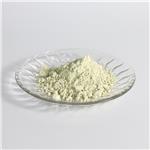Chemical Properties
Light Green Solid
Uses
Potassium ethyl xanthogenate (ethyl potassium xanthogenate) has been used:
- in synthesis of unsymmetrical sulfides via cross-coupling reaction, using recyclable CuO nanoparticles under ligand-free conditions
- as surfactant to investigate the adsorption of colloidal dye Disperse Blue 3 onto pretreated polyester fabric
- in determination of microgram amounts of cadmium in water samples by substoichiometric radiochemical method
Uses
Potassium ethyl xanthate is used as a reagent for extraction of metal ions into organic solvents and in the preparation of 2-mercapto benzimidazoles and 2-mercapto benzoxazoles by reacting with o-phenylenediamines and o-amino phenols respectively. It acts as a precursor in the production of unsymmetrical sulfides through cross-coupling reaction and as a floatation agent in the mining industry. It is involved in the determination of cadmium in water samples by substoichiometric radiochemical method and the adsorption of colloidal dye disperse Blue 3 onto pretreated polyester fabric.
Uses
As reagent in analytical chemistry.
Definition
Colorless or light-yellow crystals. Soluble in water and alcohol; insol-
uble in ether.
Hazard
Toxic by ingestion.
Flammability and Explosibility
Highly flammable
Purification Methods
Crystallise it from absolute EtOH, ligroin/ethanol or acetone by adding Et2O. Wash it with ether, then dry it in a desiccator. Its solubility in Me2CO is 8% at 25o. [Beilstein 3 H 563, 3 I 196, 3 II 367, 3 III 1101, 3 IV 1274.]
Mode of action
Potassium ethylxanthate (KEtX) has long been utilized as a collector in the flotation of chalcocite (Cu2S), bornite (Cu5FeS4), chalcopyrite (CuFeS2) and galena (PbS). KEtX acts as an inhibitor of anodic corrosion of copper in acidic sodium chloride solutions. The collection efficiency of EtX? ion is ascribed to its interaction with mineral surfaces, possibly through a chemisorption bond. A similar interaction of EtX? ions with Pb has been found. It is interesting to note that the anodic oxidation of copper of KEtX to diethyl dixanthogen should be considered according to the following equations:

Diethyl dixanthoges does not diffuse into the bulk solution but forms a physically adsorbed layer. Interactions of EtX? ions with the Cu electrode surface are first manifested by the adsorption of EtX? ions, which is then followed, at higher positive potentials, by a growth of Cu(I)EtX film. On the other hand, the inhibitory effect of EtX? may probably be explained on the basis of stabilizing the +1 oxidation state of copper in the film against further oxidation and an increase in the hydrophobicity of the metal surface[1].
References
[1] Scendo, M. “Potassium ethyl xanthate as corrosion inhibitor for copper in acidic chloride solutions.” Corrosion Science 47 7 (2005): Pages 1738-1749.






